An Artistic Mastery of Human-Khajuraho UNESCO World Heritage site,India
Khajuraho Monument
Khajuraho is an ancient city known for its magnificent temples and intricate sculptures. The city is located in the Chattarpur district of Madhya Pradesh and holds historical tales of architectural grandeur. As per the historical archives, the Khajuraho temple site had 85 temples during the 11th century spread over 20 square kilometers. Among these, only 25 temples have survived now, spread over 6 square kilometers in a picturesque landscape. The temples at Khajuraho were built during the Chandella dynasty, which reached its glory between 950 and 1050. The group of Monument belongs to two different religions – Hinduism and Jainism. They strike a perfect balance between architecture and sculpture. The Kandariya temple is decorated with a profusion of sculptures that are among the greatest masterpieces of Indian art.

History of Khajuraho Monument
The Khajuraho group of temples is an example of the culmination of northern Indian temple art and architecture. The group of monuments that form the western, eastern, and southern clusters them is rare surviving examples that display Nagara-Style architecture and graceful sculptures of nayikas (Hindu Mythological female protagonists) and deities. The splendor of the intricate statues is one of the reasons that makes it a popular site to visit among tourists. The UNESCO site of ‘Khajuraho Group of Monuments’ is famous for its temples representing various forms of meditation, spiritual teachings, and relationships through stimulating art. The temple’s fine sculptures and exceptional architectural skill, make them one of the most stunning UNESCO World Heritage Sites in India.
The Khajuraho Group of Monuments layout is Built-in sandstone and some used granite in their base construction. Each temple is elevated from its environs by a highly ornate terraced platform, on which stands the body, whose sanctum is topped by a tower, or shikhara, of a type unique to Nagara, where the verticality of the principal spire atop the sanctum is accentuated by a series of miniature spires flanking it, each symbolizing Mount Kailasa, the abode of the Gods.
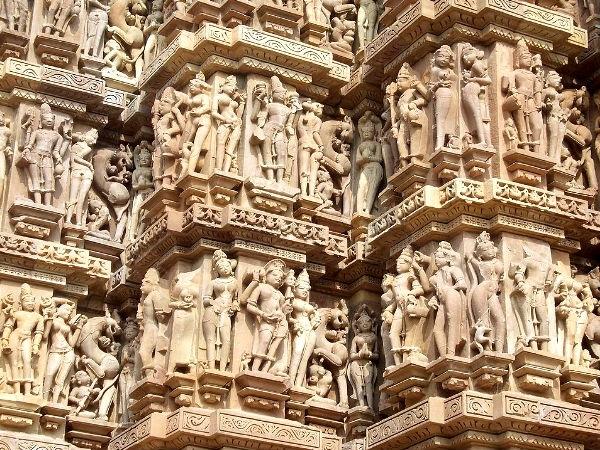
The plan of the temples shows the spatial hierarchy of axially aligned interconnected spaces. The temples are entered through an ornate entrance porch, which leads to the main hall or mandapa, through which one accesses the vestibule or antarala before reaching the sanctum (garbhagriha). The temples of Khajuraho are known for the integration of sculptures with their architecture. Sculptures depicting acts of worship, clan, minor deities, and couples in the union, all reflect the sacred belief system. Other themes mirror social life through depictions of domestic scenes, teachers and disciples, dancers and musicians, and amorous couples.
Architecture
The majority of temples at the Khajuraho monument are either Hindu (Saiva or Vaisnava) or Jain. The most famous is Chaunsat Yogini (64 tantric goddesses), built c. 875-900 CE, which has 64 shrine rooms arranged around a rectangular courtyard and the Kandariya Mahadeo built in the early 11th century CE and dedicated to Shiva. The more or less contemporary Laksmana temple was built in 954 CE by King Dhanga (r. 950-999 CE) to celebrate independence from the Gurjara-Pratihara. The Visvanatha temple (c. 1002 CE) was designed by Sutradhara Chhichchha. Both temples have shrines at each corner of their terrace platforms. Other notable temples at the site include the single-towered Caturbhuja and Vamana and the Matangeshwara temple. Khajuraho Group of Monuments is owned by the Government of India and managed by the Archaeological Survey of India.
Places to visit in Khajuraho Monument
Three main complexes of the temple are dedicated to different gods and goddesses of Hindu belief whereas some of them are dedicated to Jaina belief as well. The temples in the western complex are mainly dedicated to Hindu deities whereas the temples in the Eastern Complex are mainly dedicated to Jaina Tirthankaras.
The Western group of temples
The Western group is very close to the archaeological museum and it includes the temples of Lakshmana, Matangeshwara, Varaha, Kandariya Mahadev, Parvati, Chitragupta, Vishwanatha, and Nandi. This group of temples has approximately 870 marvelous sculptures engraved on the interior and exterior walls. The main attraction of this place is a Shivling and the beautiful floral carving in the Sanctum of the temple. The three outer sections of the walls depict the sculptures of gods, goddesses, and Hindu mythological creatures.
Chitragupta Temple
Chitragupta temple is dedicated to Lord Surya, the Sun. There is also a sculpture of 11-headed and 8-armed Lord Vishnu in the south of the temple. The sculptures of the divine couple deities Brahma-Brahmani, Shiva- Parvati, Bhairava-Bhairavi, and Lakshmi-Narayana have special sculpture and artistic features.
The Kandariya Mahadeo Temple
The Kandariya Mahadeo temple is perhaps the most eye-catching building in Khajuraho. Built around 1025 CE during the reign of Vidyadhara (r. 1004-1035 CE), The exterior has a spectacular series of towers (sikharas) which progressively reach higher from the entrance to the tallest sikhara above the temple’s sacred shrine (garbhagriha) at the rear. The main sikhara is also surrounded by quarter and half-sikharas and is topped with a large amalaka – a ribbed circular stone. The Kandariya Mahadeo temple is richly decorated with sculptures; 646 figures on the exterior and 226 inside the building. The majority of figures are a little under one meter tall and arranged in two or three tiers. They are predominantly figures of Shiva and other Hindu deities such as Vishnu, Brahma, and Ganesha, along with attendants, surasundaris (celestial maidens), and mithuna (lover) figures.
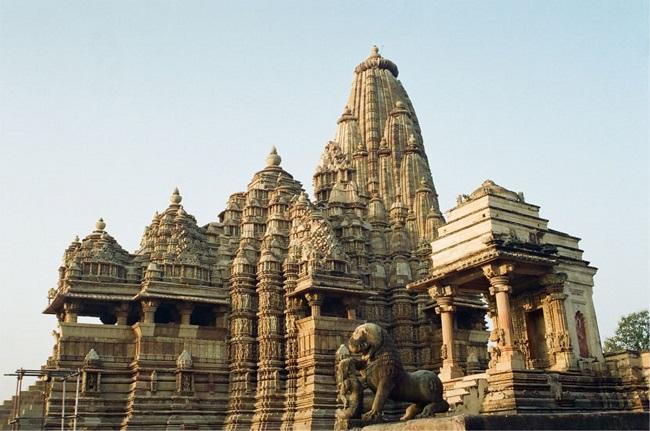
ASI Museum
This museum has some amazing sculptures and artifacts which are displayed with their names and age. An 11th – 12th-century statue of Sambhava Nath is placed in the Jain gallery which is situated on the left of the museum. A sculpture of Varaha with six heads and a dancing Ganesh are the exquisite statues to see in the museum.
The Eastern Group of Temples
Vamana Temple
Vamana Temple is dedicated to the fifth incarnation of Lord Vishnu and is built between 1050-75. This temple has a few erotic carvings and a four-armed standing Lord Vishnu on its lintel.
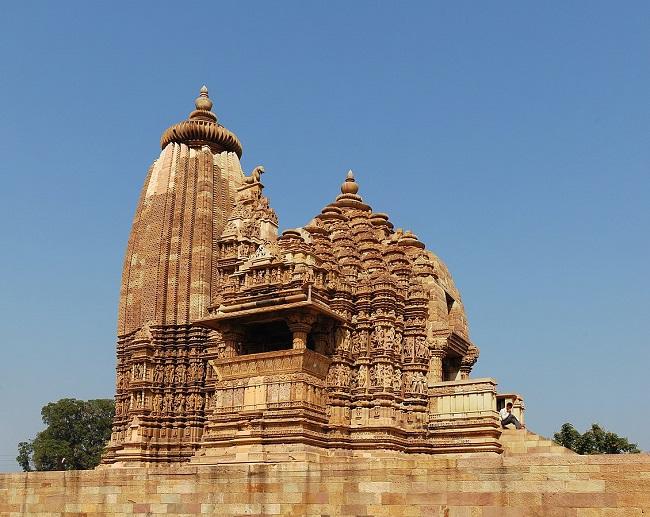
Parsvanatha Temple
This temple is one among the couple of old temples that were constructed using honey-colored sandstone. This Jain temple was built between 950-970 but also held images of deities of the Vaishnava faith, including Lord Vishnu. Adinatha Temple, Santinatha Temple, Ghantai Temple, Matangeshwara temple, and Brahma Temple are a few other temples in this group with significant architectural and historical features.
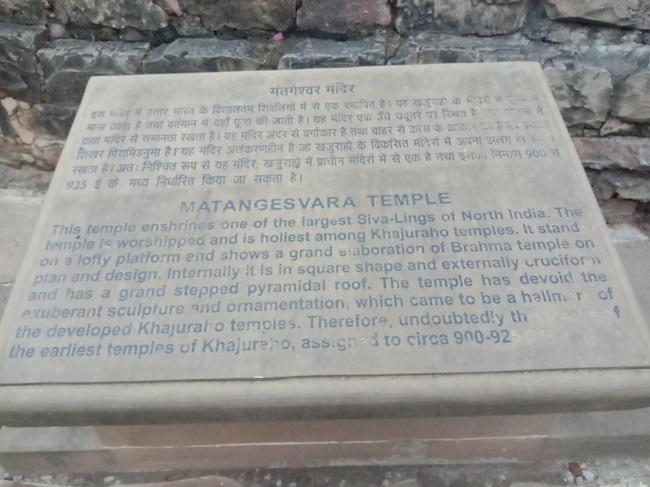
The Southern Group of Temples
Duladeo Temple
The term Dula is associated with the notion of the Bridegroom’s temple. The flying celestials on the uppermost Shikhara tower are the most impressive features of this temple. It is considered that the temple was built between 1100-1150. Chaturbhuja Temple: This temple is the only temple in Khajuraho Monument sites that does not have a single erotic sculpture. There is a marvelous sculpture of Lord Vishnu that seems as if the god is about to step out and bless his devotees.
Things to do around Khajuraho Monument
Panna National Park
Panna National Park is located in the Vindhya Ranges and spans the northern districts of Panna and Chhatarpur. The National park is home to a wide range of species of birds, Wild cats, tigers, deer, and antelopes. The reserve is located at a distance of around 100 kilometers from Khajuraho. one can go to the jungle to experience a thrilling adventure. The safari jeep drives through beautiful canyons and dense teak trees.
Raneh WaterFall
Raneh waterfall is a beautiful tourist attraction situated 21 kilometers from Khajuraho city. You can see the captivating waterfalls that create a 9m. deep canyon. Tourists can often see a rainbow hovering over the falls owing to the beaming sun.
Also, read- The Great Sanchi Stupa India-A great example of Love and War
Pandav Waterfall
Pandav Fall is situated on the route that runs through Khajuraho and Panna, 34 kilometers from Khajuraho city. The Panna National Park and the falls are quite nearby. Pandav Waterfall has a maximum height of 30 meters, and it is derived from the river Ken. The place is considered an excellent picnic spot for people residing nearby the area.
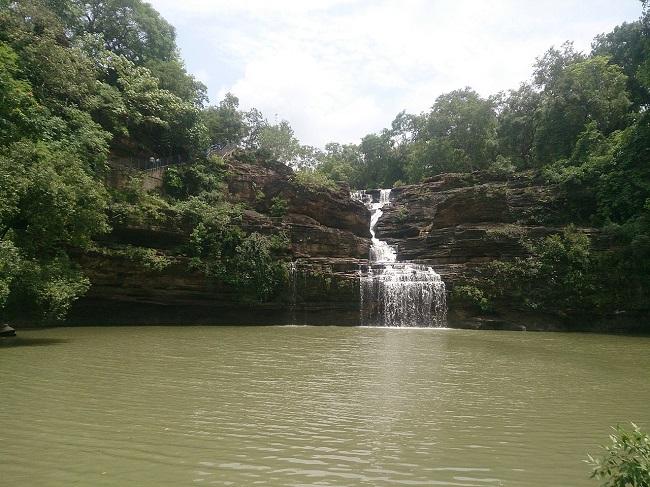
Maharaja Chhatrasal Museum
The Maharaja Chhatrasal Museum, also referred to as the Dhubela museum is 62 kilometers away from the Khajuraho group of temples. The family members of Maharaja Chhatrasal constructed this museum in 1955 at the bank of Dhubela lake.
Jain Museum
The Jain Museum is situated at a distance of 1 kilometer from the Khajuraho temple. In the garden of its campus, people can see the exquisite sculptures of the 24 Jain Tirthankaras. The interior of this museum provides information about the lives of the aforementioned Tirthankars, and it also houses many artifacts related to Jain tradition and culture.
Khajuraho Dance Festival
Khajuraho hosts a Dance Festival around February. This grand cultural extravaganza is a stunning blend of art and architecture. People can get to experience wonderful mesmerizing classical dance performances being performed by renowned artists coming from every corner of India. The Khajuraho temple complex offers sound and light shows every evening. The first show is in English language and the second, in Hindi. It is held on the open lawns in the temple premises.
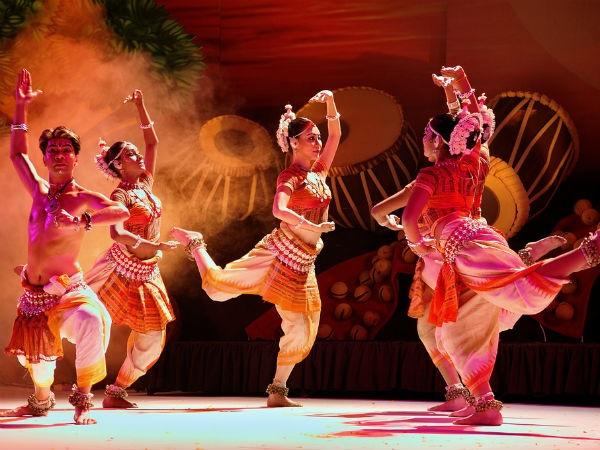
How to reach Khajuraho Monument sites
Travelers can reach Khajuraho by Train, Bus, and Air services. Khajuraho railway station is 5 km away from the main town and is linked to a few cities in Madhya Pradesh. Mahoba is the closest major railhead to Khajuraho Monument which is around 78 km away. Khajuraho has its own domestic airport at a distance of 2 km from the temple sites. It has flights connected to Delhi, Mumbai, Bhopal, and Varanasi. Khajuraho is also well linked to all the major National and State Highways. From Khajuraho, many public and private buses travel to nearby cities like Jhansi, and Gwalior
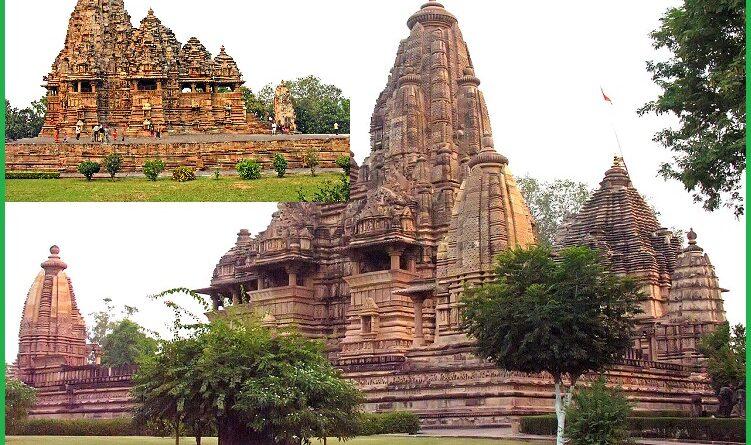
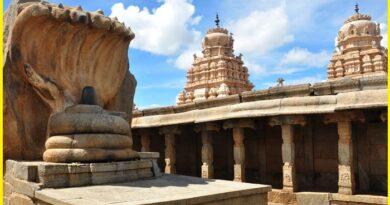
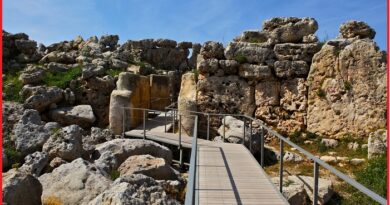
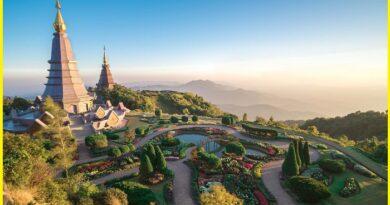
Pingback: Bharhut Stupa-Exploring the Ancient Buddhist Relic in Satna - Geotourism